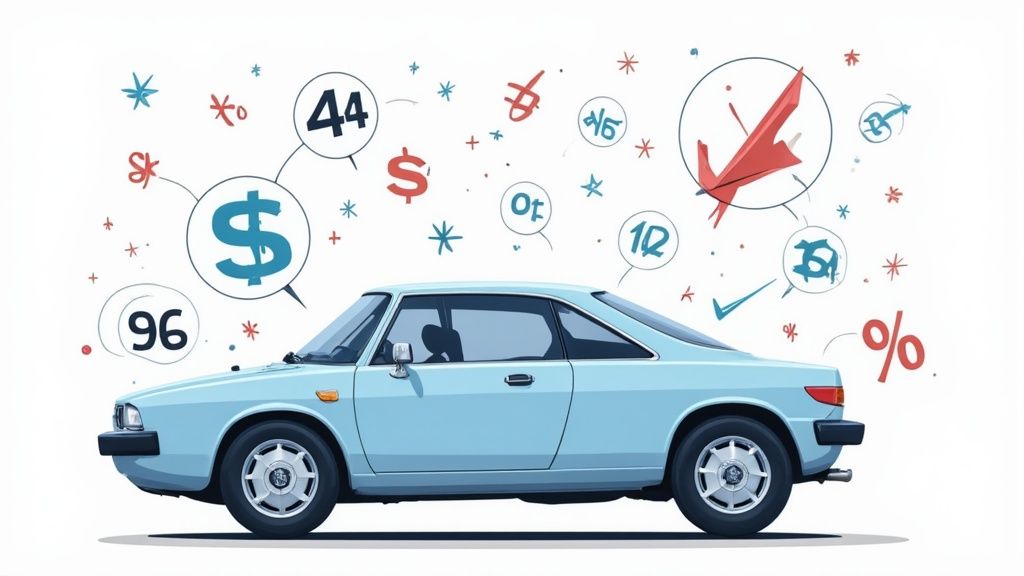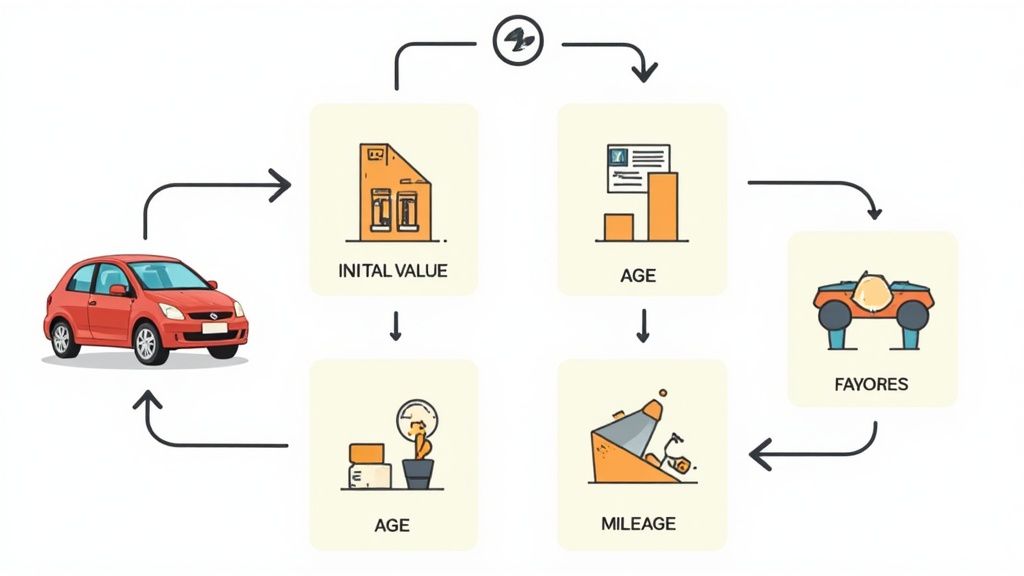
How to Calculate Vehicle Depreciation: A Comprehensive Guide for Smart Car Owners
Understanding Modern Vehicle Depreciation Dynamics

Figuring out how much a car will lose in value involves more than simple math. It requires understanding how different aspects of today’s car market affect depreciation rates. By grasping these elements, you can make smarter choices when buying a car and planning for its future resale.
Vehicle Type and Depreciation
Different types of vehicles lose value at very different rates. An SUV might keep its worth better than a sedan in some markets based on what buyers want. Two similar cars can end up with quite different resale values after just a few years.
The growth of electric and hybrid vehicles adds another factor to consider. While these eco-friendly options are becoming more popular, they often lose value faster at first compared to gas-powered cars. This is partly due to rapid improvements in battery technology and changing government incentives. Recent data shows that on average, vehicles depreciate by 38.8% over five years. Electric vehicles lose value faster at 49.1%, while trucks hold their value better at 34.8%. Luxury cars depreciate quickly at 48.1%, and hybrid vehicles have improved from 56.7% depreciation in 2019 to 37.4% recently. Discover the best and worst vehicles that hold their value.
Market Trends and Depreciation
Outside factors strongly influence how quickly cars lose value. During economic downturns, used car prices often drop, speeding up depreciation across all vehicles. Sometimes high demand for certain vehicles can slow their depreciation - for example, when gas prices spike, fuel-efficient cars become more valuable. Watching these patterns helps predict how your car’s value might change.
Understanding how vehicle types, market conditions, and new technologies work together lets you better estimate depreciation and make smarter car-buying choices. This knowledge helps you plan ahead and get the most value when it’s time to sell or trade in your vehicle.
Mastering Tax-Based Depreciation Methods

Understanding how taxes affect vehicle depreciation is key for managing business expenses. Learning IRS-approved depreciation methods can help reduce your tax obligations. Here’s what you need to know about the main approaches.
Straight-Line Depreciation: A Simple Approach
The straight-line method spreads depreciation costs evenly across a vehicle’s useful life. This basic approach works well for vehicles used less than 50% for business or when claiming the standard mileage rate. You might be interested in: How to master sitemaps.
Modified Accelerated Cost Recovery System (MACRS): Faster Depreciation
The Modified Accelerated Cost Recovery System (MACRS) provides bigger deductions early in a vehicle’s life. This benefits businesses that use vehicles heavily, though specific IRS rules must be followed.
For tax purposes, you can use either straight-line or MACRS methods. With straight-line, you divide the cost (minus trade-in) by useful life. For instance, a $30,000 vehicle with 5-year life depreciates $6,000 yearly. However, business use affects this basic calculation. Learn more about vehicle depreciation deductions here.
Choosing the Right Method for Your Situation
Your choice between depreciation methods depends on key factors like business use percentage, vehicle type, and tax planning needs. Heavy business use often makes MACRS more advantageous, while occasional business use may favor straight-line.
Documentation and Compliance
Proper records are essential for any depreciation method. Keep detailed logs of purchase price, mileage, and business use percentage. Good documentation helps meet IRS requirements and supports accurate tax filing. Understanding how the tax code classifies different vehicles also matters for correct calculations. Poor record-keeping can result in tax penalties and audit issues.
Learning these tax depreciation methods can help optimize your tax strategy and get the most financial benefit from your vehicles. The key is understanding which approach best fits your specific situation.
Calculating Mileage-Based Value Reduction

The miles on your vehicle directly affect how much it’s worth over time. As a car owner, understanding this relationship helps you make smart decisions about when to drive, sell, or trade in your vehicle. Let’s explore how mileage impacts the value of both regular gas-powered cars and electric vehicles.
Understanding Mileage-Based Depreciation
Your car’s value decreases at different rates depending on its type. Traditional gas-powered vehicles typically lose about $0.11 per mile, or 0.5% of their value per 1,000 miles. By the time these cars reach 100,000 miles, they’ve often lost about 40% of their original value. Electric vehicles tend to lose value more quickly - about $0.27 per mile or 0.75% per 1,000 miles. At 100,000 miles, EVs may have lost up to 50% of their initial worth. You can review more detailed value data here.
Strategies for Managing High Mileage
To help maintain your car’s value as the miles add up, consider these practical steps:
- Track Your Miles: Use tools like Auto Service Logger to monitor your monthly driving habits and watch for value thresholds
- Plan Your Trips: Combine errands into single trips and explore alternatives like carpooling when possible
- Keep Up with Service: Follow your maintenance schedule closely, as a well-cared-for high-mileage car holds more value
Developing Forecasting Models
Creating a simple system to predict your car’s future value helps you plan ahead:
- Record Important Data: Keep detailed notes on mileage, maintenance, and repairs using tools like Auto Service Logger
- Study the Trends: Look at your vehicle’s past depreciation to estimate future value
- Time Your Decisions: Use this information to choose the best time to sell or upgrade
By understanding how miles affect your car’s value, you can make better choices about using and maintaining your vehicle. Regular tracking and smart management of high-mileage vehicles helps protect your investment over time.
Professional Market Value Assessment Strategies

Getting an accurate value for your vehicle requires more than just a quick online search. Professional assessors combine multiple data sources and carefully analyze local market conditions to determine true market value. Understanding these methods can help you make better decisions about buying, selling, or trading your vehicle.
Using Online and In-Person Valuation Methods
Start with respected online tools like Kelley Blue Book and Edmunds for initial estimates based on basic vehicle details. However, these tools provide general guidelines rather than exact values. For a more precise assessment, consider getting an in-person appraisal from a dealership or independent assessor who can evaluate specific condition factors and local market influences. The most accurate valuations combine both digital estimates and physical inspections.
Making Smart Market Comparisons
Research similar vehicles currently listed for sale in your area - focusing on matching make, model, year and mileage. Vehicle condition significantly impacts value, so carefully evaluate how your car compares. A documented service history through platforms like Auto Service Logger can help justify higher valuations. You might find this useful: How to master sitemaps and other useful tools. Consider key factors like:
- Exterior appearance and paint condition
- Interior wear and cleanliness
- Mechanical health and maintenance records
Understanding Value-Adding Features
Certain characteristics can meaningfully increase a vehicle’s market appeal and price. Popular options that boost value include:
- Leather upholstery
- Sunroof/moonroof
- Advanced safety systems
- Below-average mileage
- Clean vehicle history
- Recent major services
These features become especially important when setting asking prices or negotiating deals. Keeping detailed maintenance records helps document and preserve these value-adding elements over time. Understanding how different features affect local buyer preferences allows for more strategic pricing decisions.
Advanced Value Retention Techniques
Keeping your vehicle’s value high requires smart maintenance practices, careful timing, and strategic upgrades. Understanding vehicle depreciation and how to minimize it can help you maintain more of your car’s worth over time.
Strategic Maintenance and Documentation
A solid maintenance routine forms the foundation of value retention. Schedule service milestones to align with warranty coverage periods to help manage costs. Document all maintenance and repairs thoroughly using tools like Auto Service Logger to create a complete service history. Well-organized maintenance records typically lead to better resale prices.
Smart Upgrades and Market Timing
Not all vehicle upgrades contribute equally to value retention. Focus on adding features that buyers actively seek, such as advanced safety systems like backup cameras and lane departure warnings. Consider seasonal patterns when planning to sell - spring and summer often bring higher prices in many markets. Timing your sale during peak demand periods can help maximize your return.
Research-Based Investment Decisions
Stay informed about which vehicle features and technologies command premium prices. Features like modern infotainment systems often appeal strongly to buyers seeking connected vehicles. Use market data to guide your upgrade decisions and ensure your investments will pay off when it’s time to sell.
Customized Value Protection Strategy
Build a value retention plan that matches your specific situation and goals. Consider your typical mileage, driving conditions, and how long you plan to keep the vehicle. For high-mileage drivers, focusing on mechanical maintenance becomes especially important. Learn more about tracking and documentation tools in our guide on How to master sitemaps and other useful tools.
By understanding depreciation factors and taking proactive steps to counter them, you can better protect your vehicle’s value. Regular maintenance, strategic upgrades, and smart timing work together to preserve worth and position you for successful future sales. Stay current with automotive trends to keep your value retention strategy effective over time.
Practical Applications and Case Studies
Understanding vehicle depreciation in concrete terms helps illustrate how these calculations work in everyday situations. Let’s examine three real examples that demonstrate key principles of vehicle value over time.
Case Study 1: The Impact of Mileage on a Family Sedan
A family purchased a 2020 Honda Accord for $25,000 and drove it 12,000 miles per year for three years, accumulating 36,000 total miles. Using the standard mileage-based depreciation rate of $0.11 per mile, the car lost $3,960 in value (36,000 x $0.11). This brought its current estimated value to $21,040. The steady annual mileage created a clear depreciation pattern that was easy to track.
Case Study 2: Business Tax Benefits for a Luxury SUV
A business owner bought a 2022 BMW X5 for $60,000, using it over 50% for business purposes. They chose the Modified Accelerated Cost Recovery System (MACRS) for tax reporting. This method allowed significant first-year deductions, showing how smart depreciation choices can provide tax advantages for business vehicle owners.
Case Study 3: Maintaining Value in a Classic Car
The owner of a 1967 Ford Mustang took a strategic approach to preserving its value. They kept complete maintenance records using Auto Service Logger and focused on authentic restorations using original parts. Their careful documentation and thoughtful upgrades helped the car retain more value than typical vehicles of its age, proving that proper care directly impacts resale value.
Applying These Lessons to Your Situation
These examples show why tracking depreciation matters for every vehicle owner. Regular mileage records, consistent maintenance logs, and understanding how vehicle type affects value loss all play key roles in managing ownership costs. Using tools like Auto Service Logger helps create the detailed history that can improve resale value.
Want to start tracking your vehicle’s maintenance and protect its value? Begin documenting your service history with Auto Service Logger today.